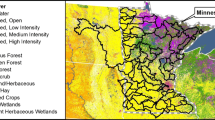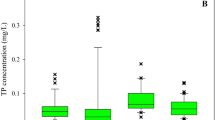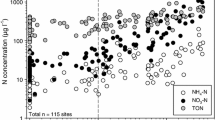Abstract
Anthropogenic activities have led to increased transfers of nitrogen (N) and phosphorus (P) to surface waters where changes in the absolute amounts of N and P delivery, and in N:P ratios, threaten water quality. While models of riverine fluxes are increasingly good at predicting total annual nutrient loads, our understanding of which features of a watershed differentially affect N and P transport downstream is still limited. In this study, we used linear mixed models to quantify the relative transport of N and P through different landscape and limnoscape compartments (e.g. hill slopes, lakes, reservoirs,) under a variety of climate regimes over 26 years in 18 watersheds of the St. Lawrence Basin. Water retention capacity and precipitation patterns were the features that most strongly influenced nutrient export from land to water, where P was preferentially retained in the landscape over N when water retention capacity was highest. Lakes and reservoirs also emerged as features that influenced nutrient fluxes, where lakes preferentially retain more P over N and reservoirs tended to export N. Factors that favor erosion, such as flashiness of precipitation and land-use change also alter N:P ratios in receiving waters, largely by mobilizing legacy sources of P.





Similar content being viewed by others
References
Alexander RB, Smith RA, Schwarz GE, Boyer EW, Nolan JV, Brakebill JW (2008) Differences in phosphorus and nitrogen delivery to the gulf of Mexico from the Mississippi river basin. Environ Sci Technol 42:822–830
Appling AP, Leon MC, McDowell WH (2015) Reducing bias and quantifying uncertainty in watershed flux estimates: the R package loadflex. Ecosphere 6:1–25
Arbuckle KE, Downing JA (2001) The influence of watershed land use on lake N:P in a predominantly agricultural landscape. Limnol Oceanogr 46:970–975
Banque de Données Sur la Qualité du Milieu Aquatique (BQMA; Ministère du Développement Durable, de l’Environnement et de la Lutte Contre les Changements Climatiques) (2018) http://www.mddelcc.gouv.qc.ca/eau/Atlas_interactif/donnees_recentes/donnees_p_tot.asp#onglets
Bates D, Mächler M, Bolker B, Walker S (2014) Fitting linear mixed-effects models using lme4. arXiv:1406.5823
Bernhardt ES, Blaszczak JR, Ficken CD, Fork ML, Kaiser KE, Seybold EC (2017) Control points in ecosystems: moving beyond the hot spot hot moment concept. Ecosystems 20:665–682
Billen G, Garnier J (1999) Nitrogen transfers through the Seine drainage network: a budget based on the application of theRiverstrahler’model. Hydrobiologia 410:139–150
Blanchet FG, Legendre P, Borcard D (2008) Forward selection of explanatory variables. Ecology 89:2623–2632
Budyko MI (1974) Climate and Life. In: David H (ed) Miller. Academic Press, San Diego
Carpenter SR (2005) Eutrophication of aquatic ecosystems: bistability and soil phosphorus. Proc Natl Acad Sci USA 102:10002–10005
Carpenter SR, Caraco NF, Correll DL, Howarth RW, Sharpley AN, Smith VH (1998) Nonpoint pollution of surface waters with phosphorus and nitrogen. Ecol Appl 8:559–568
Carpenter SR, Booth EG, Kucharik CJ (2017) Extreme precipitation and phosphorus loads from two agricultural watersheds. Limnol Oceanogr 63:1221–1233
Carrascal LM, Galván I, Gordo O (2009) Partial least squares regression as an alternative to current regression methods used in ecology. Oikos 118:681–690
Centre d’Expertise Hydrique du Québec (2018) https://www.cehq.gouv.qc.ca/
Chen F, Hou L, Liu M, Zheng Y, Yin G, Lin X, Li X, Zong H, Deng F, Gao J (2016) Net anthropogenic nitrogen inputs (NANI) into the Yangtze River basin and the relationship with riverine nitrogen export. J Geophys Res 121:451–465
Chen D, Shen H, Hu M, Wang J, Zhang Y, Dahlgren RA (2018) Legacy nutrient dynamics at the watershed scale: principles, modeling, and implications. Adv Agron 149:237–313
Cohen J, Cohen P, West SG, Aiken LS (2013) Applied multiple regression/correlation analysis for the behavioral sciences. Routledge, London
Collins SM, Oliver SK, Lapierre JF, Stanley EH, Jones JR, Wagner T, Soranno PA (2017) Lake nutrient stoichiometry is less predictable than nutrient concentrations at regional and sub-continental scales. Ecol Appl 27:1529–1540
Cooke SE, Prepas EE (1998) Stream phosphorus and nitrogen export from agricultural and forested watersheds on the Boreal Plain. Can J Fish Aquat Sci 55:2292–2299
Dodds WK, Bouska WW, Eitzmann JL, Pilger TJ, Pitts KL, Riley AJ, Schloesser JT, Thornbrugh DJ (2009) Eutrophication of US freshwaters: analysis of potential economic damages. Environ Sci Technol 43:12–19
Enders CK, Tofighi D (2007) Centering predictor variables in cross-sectional multilevel models: a new look at an old issue. Psychol Methods 12:121
Frank H, Patrick S, Peter W, Hannes F (2000) Export of dissolved organic carbon and nitrogen from Gleysol dominated catchments—the significance of water flow paths. Biogeochemistry 50:137–161
Galloway JN, Dentener FJ, Capone DG, Boyer EW, Howarth RW, Seitzinger SP, Asner GP, Cleveland CC, Green PA, Holland EA, Karl DM, Michaels AF, Porter JH, Townsend AR, Vorosmarty CJ (2004) Nitrogen cycles: past, present, and future. Biogeochemistry 70:153–226
Goyette JO, Bennett EM, Howarth RW, Maranger R (2016) Changes in anthropogenic nitrogen and phosphorus inputs to the St. Lawrence sub-basin over 110 years and impacts on riverine export. Global Biogeochem Cycles 30:1000–1014
Goyette J-O, Bennett E, Maranger R (2018) Low buffering capacity and slow recovery of anthropogenic phosphorus pollution in watersheds. Nat Geosci. https://doi.org/10.1038/s41561-018-0238-x
Graham MH (2003) Confronting multicollinearity in ecological multiple regression. Ecology 84:2809–2815
Grantz EM, Haggard BE, Scott JT (2014) Stoichiometric imbalance in rates of nitrogen and phosphorus retention, storage, and recycling can perpetuate nitrogen deficiency in highly-productive reservoirs. Limnol Oceanogr 59:2203–2216
Green MB, Finlay JC (2010) Patterns of hydrologic control over stream water total nitrogen to total phosphorus ratios. Biogeochemistry 99:15–30
Green MB, Nieber JL, Johnson G, Magner J, Schaefer B (2007) Flow path influence on an N:P ratio in two headwater streams: a paired watershed study. J Geophys Res. https://doi.org/10.1029/2007JG000403
Hamilton SK (2012) Biogeochemical time lags may delay responses of streams to ecological restoration. Freshw Biol 57:43–57
Hansen AT, Dolph CL, Foufoula-Georgiou E, Finlay JC (2018) Contribution of wetlands to nitrate removal at the watershed scale. Nat Geosci 11:127
Harrison JA, Maranger RJ, Alexander RB, Giblin AE, Jacinthe P-A, Mayorga E, Seitzinger SP, Sobota DJ, Wollheim WM (2009) The regional and global significance of nitrogen removal in lakes and reservoirs. Biogeochemistry 93:143–157
Hayes NM, Deemer BR, Corman JR, Razavi NR, Strock KE (2017) Key differences between lakes and reservoirs modify climate signals: a case for a new conceptual model. Limnol Oceanogr Lett 2:47–62
Heathwaite L, Haygarth P, Matthews R, Preedy N, Butler P (2005) Evaluating colloidal phosphorus delivery to surface waters from diffuse agricultural sources. J Environ Qual 34:287–298
Hill A, Kemp W, Buttle J, Goodyear D (1999) Nitrogen chemistry of subsurface storm runoff on forested Canadian Shield hillslopes. Water Resour Res 35:811–821
Holtan H, Kamp-Nielsen L, Stuanes A (1988) Phosphorus in soil, water and sediment: an overview. Hydrobiologia 170:19–34
Hong B, Swaney DP, Mörth C-M, Smedberg E, Eriksson Hägg H, Humborg C, Howarth RW, Bouraoui F (2012) Evaluating regional variation of net anthropogenic nitrogen and phosphorus inputs (NANI/NAPI), major drivers, nutrient retention pattern and management implications in the multinational areas of Baltic Sea basin. Ecol Model 227:117–135
Howarth RW, Billen G, Swaney D, Townsend A, Jaworski N, Lajtha K, Downing JA, Elmgren R, Caraco N, Jordan T, Berendse F, Freney J, Kudeyarov V, Murdoch P, Zhu ZL (1996) Regional nitrogen budgets and riverine N&P fluxes for the drainages to the North Atlantic Ocean: natural and human influences. Biogeochemistry 35:75–139
Howarth R, Swaney D, Boyer E, Marino R, Jaworski N, Goodale C (2006) The influence of climate on average nitrogen export from large watersheds in the Northeastern United States. Biogeochemistry 79:163–186
Howarth R, Chan F, Conley DJ, Garnier J, Doney SC, Marino R, Billen G (2011) Coupled biogeochemical cycles: eutrophication and hypoxia in temperate estuaries and coastal marine ecosystems. Front Ecol Environ 9:18–26
Howarth R, Swaney D, Billen G, Garnier J, Hong BG, Humborg C, Johnes P, Morth CM, Marino R (2012) Nitrogen fluxes from the landscape are controlled by net anthropogenic nitrogen inputs and by climate. Front Ecol Environ 10:37–43
Huang H, Chen D, Zhang B, Zeng L, Dahlgren RA (2014) Modeling and forecasting riverine dissolved inorganic nitrogen export using anthropogenic nitrogen inputs, hydroclimate, and land-use change. J Hydrol 517:95–104
IPCC (2014) Climate change 2014–impacts, adaptation and vulnerability: regional aspects. Cambridge University Press, Cambridge
Jarvie HP, Sharpley AN, Spears B, Buda AR, May L, Kleinman PJ (2013) Water quality remediation faces unprecedented challenges from” legacy phosphorus”. Environ Sci Technol 47:8997–8998
Joosse P, Baker D (2011) Context for re-evaluating agricultural source phosphorus loadings to the Great Lakes. Can J Soil Sci 91:317–327
Kalff J (2002) Limnology: inland water ecosystems. Prentice Hall, Upper Saddle River
Kirchner W, Dillon P (1975) An empirical method of estimating the retention of phosphorus in lakes. Water Resour Res 11:182–183
Kõiv T, Nõges T, Laas A (2011) Phosphorus retention as a function of external loading, hydraulic turnover time, area and relative depth in 54 lakes and reservoirs. Hydrobiologia 660:105–115
Kroeze C, Bouwman L, Seitzinger S (2012) Modeling global nutrient export from watersheds. Curr Opin Environ Sustain 4:195–202
Kusmer AS, Goyette J-O, MacDonald GK, Bennett EM, Maranger R, Withers PJA (2018) Watershed buffering of legacy phosphorus pressure at a regional scale: a comparison across space and time. Ecosystems. https://doi.org/10.1007/s10021-018-0255-z
Larsen DP, Mercier H (1976) Phosphorus retention capacity of lakes. J Fisheries Board Can 33:1742–1750
Maavara T, Parsons CT, Ridenour C, Stojanovic S, Dürr HH, Powley HR, Van Cappellen P (2015) Global phosphorus retention by river damming. Proc Natl Acad Sci USA 112:15603–15608
Maranger R, Jones SE, Cotner JB (2018) Stoichiometry of carbon, nitrogen, and phosphorus through the freshwater pipe. Limnol Oceanogr Lett 3:89–101
Mason RL, Gunst RF, Hess JL (2003) Statistical design and analysis of experiments: with applications to engineering and science. Wiley, London
McIsaac GF, David MB, Gertner GZ, Goolsby DA (2001) Eutrophication: nitrate flux in the Mississippi River. Nature 414:166
McKenney DW, Hutchinson MF, Papadopol P, Lawrence K, Pedlar J, Campbell K, Milewska E, Hopkinson RF, Price D, Owen T (2011) Customized spatial climate models for North America. Bull Am Meteor Soc 92:1611–1622
Mulholland PJ, Helton AM, Poole GC, Hall RO, Hamilton SK, Peterson BJ, Tank JL, Ashkenas LR, Cooper LW, Dahm CN (2008) Stream denitrification across biomes and its response to anthropogenic nitrate loading. Nature 452:202–205
Nakagawa S, Schielzeth H (2013) A general and simple method for obtaining R2 from generalized linear mixed-effects models. Methods Ecol Evol 4:133–142
Natural Resources Canada (2003), National scale frameworks hydrology—Drainage network, Canada (digital dataset). http://geogratis.cgdi.gc.ca/. Accessed June 2018
Newbold JD, Elwood JW, O’Neill RV, Winkle WV (1981) Measuring nutrient spiralling in streams. Can J Fish Aquat Sci 38:860–863
Nixon SW, Ammerman JW, Atkinson LP, Berounsky VM, Billen G, Boicourt WC, Boynton WR, Church TM, Ditoro DM, Elmgren R, Garber JH, Giblin AE, Jahnke RA, Owens NJP, Pilson MEQ, Seitzinger SP (1996) The fate of nitrogen and phosphorus at the land sea margin of the North Atlantic Ocean. Biogeochemistry 35:141–180
Nowlin WH, Evarts JL, Vanni MJ (2005) Release rates and potential fates of nitrogen and phosphorus from sediments in a eutrophic reservoir. Freshw Biol 50:301–322
Ockenden M, Deasy CE, Benskin CMH, Beven KJ, Burke S, Collins AL, Evans R, Falloon PD, Forber KJ, Hiscock KM (2016) Changing climate and nutrient transfers: evidence from high temporal resolution concentration-flow dynamics in headwater catchments. Sci Total Environ 548:325–339
Paerl HW (2009) Controlling eutrophication along the freshwater–marine continuum: dual nutrient (N and P) Reductions are Essential. Estuar Coasts 32:593–601
Pellerin S, Poulin M (2013) Analyse de la situation des milieux humides au Québec et recommandations à des fins de conservation et de gestion durable. Rapport final présenté au Ministère du développement durable, de l’environnement, de la faune et des parcs
Powers S, Tank J, Robertson D (2015) Control of nitrogen and phosphorus transport by reservoirs in agricultural landscapes. Biogeochemistry 124:417–439
Price K (2011) Effects of watershed topography, soils, land use, and climate on baseflow hydrology in humid regions: a review. Prog Phys Geogr 35:465–492
Roderick ML, Farquhar GD (2011) A simple framework for relating variations in runoff to variations in climatic conditions and catchment properties. Water Resour Res 47:12
Runkel RL, Crawford CG, Cohn TA (2004) Load estimator (LOADEST): a FORTRAN program for estimating constituent loads in streams and rivers. CreateSpace Independent Publishing, Scotts Valley, pp 2328–7055
Russell MJ, Weller DE, Jordan TE, Sigwart KJ, Sullivan KJ (2008) Net anthropogenic phosphorus inputs: spatial and temporal variability in the Chesapeake Bay region. Biogeochemistry 88:285–304
Saunders DL, Kalff J (2001) Nitrogen retention in wetlands, lakes and rivers. Hydrobiologia 443:205–212
Schlesinger WH, Bernhardt ES (2013) Biogeochemistry: an analysis of global change. Academic Press, New York
Scott JT, McCarthy MJ, Otten TG, Steffen MM, Baker BC, Grantz EM, Wilhelm SW, Paerl HW, Smith R (2013) Comment: an alternative interpretation of the relationship between TN: TP and microcystins in Canadian lakes. Can J Fish Aquat Sci 70:1265–1268
Sebilo M, Mayer B, Nicolardot B, Pinay G, Mariotti A (2013) Long-term fate of nitrate fertilizer in agricultural soils. Proc Natl Acad Sci USA 110:18185–18189
Seitzinger S, Harrison JA, Böhlke J, Bouwman A, Lowrance R, Peterson B, Tobias C, Drecht GV (2006) Denitrification across landscapes and waterscapes: a synthesis. Ecol Appl 16:2064–2090
Seitzinger SP, Mayorga E, Bouwman AF, Kroeze C, Beusen AHW, Billen G, Van Drecht G, Dumont E, Fekete BM, Garnier J, Harrison JA (2010) Global river nutrient export: a scenario analysis of past and future trends. Glob Biogeochem Cycles 24:4
Sharpley A, Jarvie HP, Buda A, May L, Spears B, Kleinman P (2013) Phosphorus legacy: overcoming the effects of past management practices to mitigate future water quality impairment. J Environ Qual 42:1308–1326
Soranno PA, Webster KE, Riera JL, Kratz TK, Baron JS, Bukaveckas PA, Kling GW, White DS, Caine N, Lathrop RC (1999) Spatial variation among lakes within landscapes: ecological organization along lake chains. Ecosystems 2:395–410
Soranno PA, Cheruvelil KS, Wagner T, Webster KE, Bremigan MT (2015) Effects of land use on lake nutrients: the importance of scale, hydrologic connectivity, and region. PLoS ONE 10:e0135454
Soulsby C, Tetzlaff D, Rodgers P, Dunn S, Waldron S (2006) Runoff processes, stream water residence times and controlling landscape characteristics in a mesoscale catchment: an initial evaluation. J Hydrol 325:197–221
Stanley EH, Doyle MW (2002) A geomorphic perspective on nutrient retention following dam removal: geomorphic models provide a means of predicting ecosystem responses to dam removal. AIBS Bull 52:693–701
Sterner RW, Elser JJ (2002) Ecological stoichiometry: the biology of elements from molecules to the biosphere. Princeton University Press, Princeton
Swaney DP, Hong B, Ti C, Howarth RW, Humborg C (2012) Net anthropogenic nitrogen inputs to watersheds and riverine N export to coastal waters: a brief overview. Curr Opin Environ Sustain 4:203–211
Team, R. C. 2013. R: A language and environment for statistical computing
Teodoru C, Wehrli B (2005) Retention of sediments and nutrients in the Iron Gate I Reservoir on the Danube River. Biogeochemistry 76:539–565
Tesoriero AJ, Duff JH, Saad DA, Spahr NE, Wolock DM (2013) Vulnerability of streams to legacy nitrate sources. Environ Sci Technol 47:3623–3629
Thornton KW, Kimmel BL, Payne FE (1990) Reservoir limnology: ecological perspectives. Wiley, New Jersey
Van de Waal DB, Smith VH, Declerck SA, Stam E, Elser JJ (2014) Stoichiometric regulation of phytoplankton toxins. Ecol Lett 17:736–742
Van Meter KJ, Basu NB (2015) Catchment legacies and time lags: a parsimonious watershed model to predict the effects of legacy storage on nitrogen export. PLoS ONE 10:e0125971
Van Meter K, Basu N, Van Cappellen P (2017) Two centuries of nitrogen dynamics: legacy sources and sinks in the Mississippi and Susquehanna River Basins. Global Biogeochem Cycles 31:2–23
Van Meter K, Van Cappellen P, Basu N (2018) Legacy nitrogen may prevent achievement of water quality goals in the Gulf of Mexico. Science 360:427–430
Vollenweider RA (1976) Advances in defining critical loading levels for phosphorus in lake eutrophication. Memorie dell’Istituto Italiano di Idrobiologia, Dott. Marco de Marchi Verbania Pallanza
Vought LB-M, Dahl J, Pedersen CL, Lacoursiere JO (1994) Nutrient retention in riparian ecotones. AMBIO 23:342–348
Wollheim WM, Vörösmarty C, Peterson BJ, Seitzinger SP, Hopkinson CS (2006) Relationship between river size and nutrient removal. Geophys Res Lett 33:6
Wollheim WM, Vörösmarty CJ, Bouwman A, Green P, Harrison J, Linder E, Peterson BJ, Seitzinger SP, Syvitski JP (2008) Global N removal by freshwater aquatic systems using a spatially distributed, within basin approach. Glob Biogeochem Cycles. https://doi.org/10.1029/2007GB002963
Wurtsbaugh WA, Baker MA, Gross H, Brown P (2005) Lakes as nutrient “sources” for watersheds: a landscape analysis of the temporal flux of nitrogen through sub-alpine lakes and streams. Internationale Vereinigung für theoretische und angewandte Limnologie: Verhandlungen 29:645–649
Zhou M, Brandt P, Pelster D, Rufino MC, Robinson T, Butterbach-Bahl K (2014) Regional nitrogen budget of the Lake Victoria Basin, East Africa: syntheses, uncertainties and perspectives. Environ Res Lett 9:105009
Zhou G, Wei X, Chen X, Zhou P, Liu X, Xiao Y, Sun G, Scott DF, Zhou S, Han L (2015) Global pattern for the effect of climate and land cover on water yield. Nat Commun 6:5918
Zuur A, Ieno EN, Walker N, Saveliev AA, Smith GM (2009) Mixed effects models and extensions in ecology with R. Springer Science & Business Media, New York
Acknowledgements
We thank JF Lapierre, M Botrel, N Fortin St Gelais and other members of the Maranger lab for helpful suggestions. We thank two anonymous reviewers for helpful comments that improved the manuscript. This research was supported by Fonds de Recherche Nature et Technologie du Québec (FQRNT) and Groupe de Recherche Interuniversitaire en Limnologie et environnement aquatique (GRIL) student scholarship Grants to JOG and a National Science and Engineering Research Council of Canada (NSERC) Discovery Grant to RM.
Author information
Authors and Affiliations
Corresponding author
Additional information
Publisher's Note Springer Nature remains neutral with regard to jurisdictional claims in published maps and institutional affiliations.
Responsible Editor: J.M. Melack.
Electronic supplementary material
Below is the link to the electronic supplementary material.
Rights and permissions
About this article
Cite this article
Goyette, JO., Bennett, E.M. & Maranger, R. Differential influence of landscape features and climate on nitrogen and phosphorus transport throughout the watershed. Biogeochemistry 142, 155–174 (2019). https://doi.org/10.1007/s10533-018-0526-y
Received:
Accepted:
Published:
Issue Date:
DOI: https://doi.org/10.1007/s10533-018-0526-y




